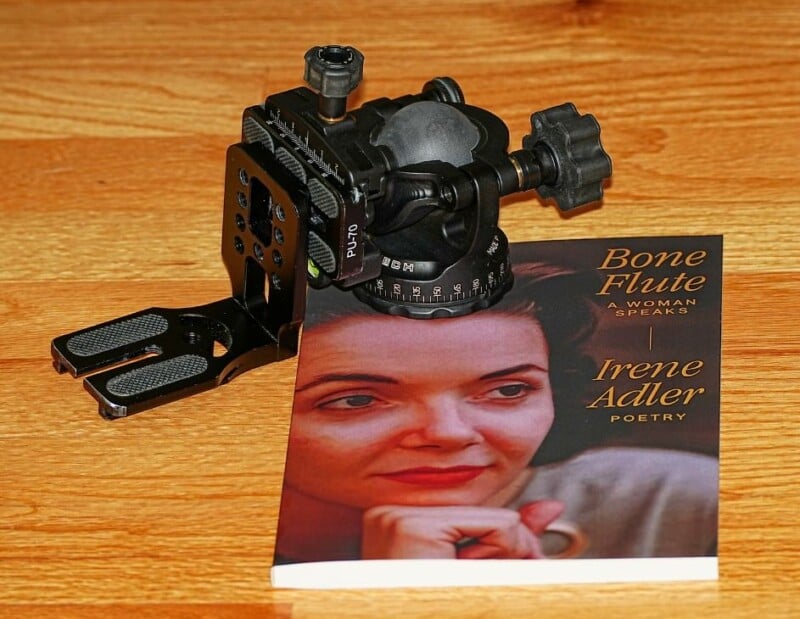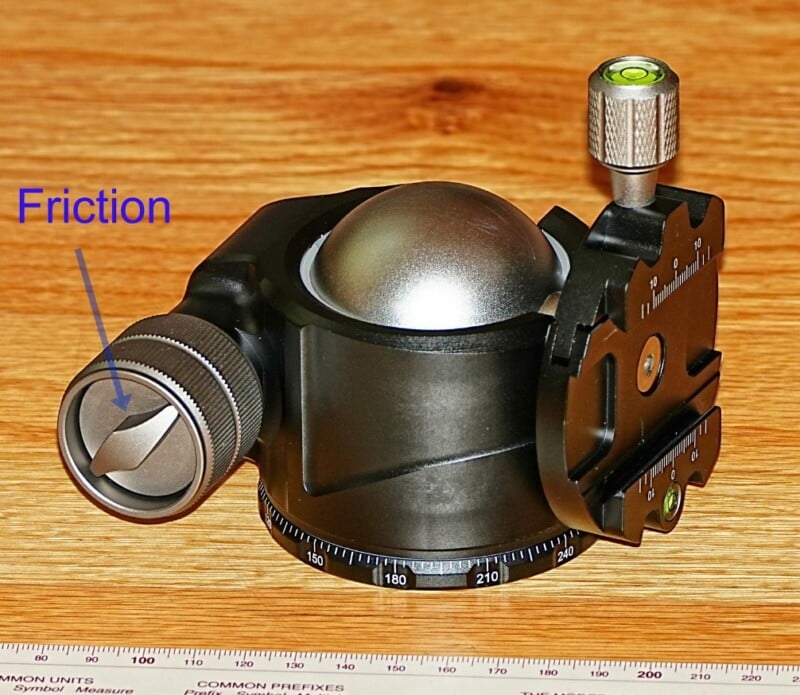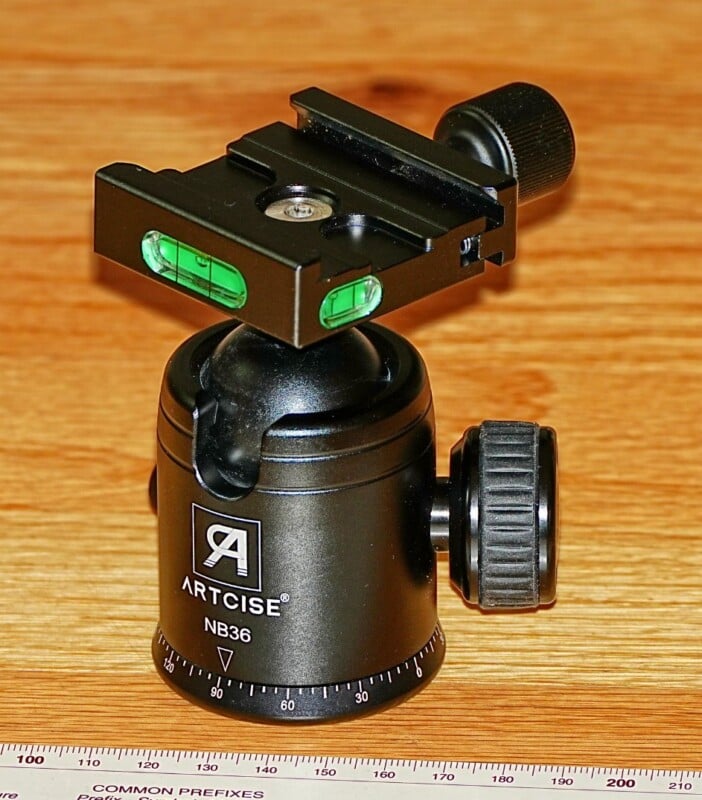Unlocking the Power of Tripod Ball Heads with Balanced Mode
![]()
Since I started using ball heads in balanced mode, I’ve been a very happy camper. In this article, I’ll be sharing a review of multiple ball heads as well as a tutorial about using ball heads in the balanced mode.

![]()
The Ball Heads
When I first saw a ball head 40 years ago at Keeble & Schucat Camera Store in Palo Alto, I thought it looked very cool and bought it with no idea of what to do with it. I still have it.
![]()
It sat on my shelf for decades. Mounting my camera on the ball resulted in an unwieldy floppy setup. Why would anyone want so much lateral tilt? Eventually, I discovered the balanced way to use it, and that works great. But I never see people do this. They are missing something.
![]()
Balanced portrait mode clamps to a simple Arca plate on the bottom of the camera. You can see how the pivot (extending from the right side of the ball) is aligned with the center of gravity of the camera.
![]()
Balanced landscape mode requires a rotating lens foot or an L bracket like this. Again, the pivot is aligned with the center of gravity of the camera.
At least one other guy knows about ball heads in the balanced mode. Scott Dordick, owner of Acratech has invented a bearing at the neck, just under the ball to reduce friction in the balanced mode. He calls this mode a gimbal. In this article, I’ll call it balanced mode.
If you haven’t tried the balanced mode, it will put a smile on your face. Flops, sags, and all those tripod head troubles will disappear. Almost all tripod heads, video and photo heads also flop and sag. That’s because the center of gravity of the camera is well above the altitude pivot. The ball head balanced mode locates the altitude pivot at the center of gravity of the camera and banishes flops and sags.
I’ve watched some videos recommending video heads over ball heads. None of the experienced photographers presenting these videos show the balanced way to use a ball head. I’m surprised. Using the ball head in balanced mode is much better than a video head which they recommend. That’s because when the ball head is in balanced mode, the altitude axis passes through the center of gravity of the camera. So you can leave it in any position unlocked and it just stays there. No need to lock, no flop, no sag when you do lock. You can’t do that with a video head because the camera’s center of gravity is well above the altitude axis!
This article will review ball heads both used normally and as balanced heads. We’ll try some high-end heads and some inexpensive heads that work well. First, let’s get some heads that can’t function in the balanced mode out of the way.
![]()
Upside-down ball heads, like this Leofoto, don’t have a notch.
I bought this because it looked cool. But lacking a notch, it won’t work as balanced, so I can’t recommend it. Ditto for all other upside-down heads like Arca-Swiss PO. Also ditto for some sideways heads like the Gitzo off-center. We need an ordinary vertical center ball head with at least one notch.
![]()
I also prefer knobs over levers like this above. Levers are hard to find by feel when your eye is buried in the EVF and they are uncomfortable to lock. They also often interfere with the Arca clamp.
Most ball heads have 3 knobs:
The knobs are Azimuth Lock, Ball Lock, and Ball Friction. Ball friction knobs are becoming harder to find. Some manufacturers call a 3rd knob “Friction”, but it’s often something else. A real ball friction knob compresses a spring which presses on a brake pad. It was nice to have, but not essential. More about this in the discussion of each ball head.
In this article, Novoflex, FLM, Promedia, and Acratech are at the top of the price range. The remaining ball heads are inexpensive Chinese heads, mostly in the range of $50 to $100. Most are quite good.
The Top Dogs
Novoflex Classic 3
![]()
$676, 597g. Well made in Germany. Smooth motion. Locks with the little lever above. The blue ring around the body is a friction control. That looked like a nice idea until I used it and discovered that it took two hands; one to prevent the body from rotating and the other to rotate the blue ring. (One hand is enough if the body is locked in azimuth, but I usually leave that loose). The blue ring is slippery and can’t achieve enough friction to hold up my A7R5 with only a 280g lens. Motion with the ball pointing sideways in my preferred balanced mode is stiff. I reluctantly give it 2 points out of 10 because of the poor friction ring. That’s pretty harsh, but for this money, it should work better.
FLM CB-43FT II
![]()
640g. This FLM model is no longer available. Also well-made in Germany. It has a unique optional mode that can clamp the sides of the ball, constraining motion to altitude only, like a video head. The friction control is also unique, but very frustrating. This article by a lover of FLM ball heads presents a seven-step procedure to set the friction control for a single camera and lens. And it should be redone each time you change the lens or camera. Then it requires a whopping 180 to 270 degrees of rotation of the main knob to lock the ball. 4 points out of 10.
Promedia BH1
![]()
$499, 902g. Very well made. Large comfortable knobs. The 61mm ball you see is an outer shell. The actual ball is 46mm.
This head doesn’t have a notch. But it can function in the balanced mode with the stud in the position shown here. It’s hard to find satisfactory tension in either the ball head mode or the balanced mode. This is due to unevenness in the ball and/or clamping surface. Promedia kindly loaned me this head for review and I assume that they wouldn’t have sent me a defective head, so this must be the way they make them.
Reluctantly, I give this head a 5. It works, but not very well.
Acratech GXP
![]()

$510, 454g. I discovered it by reading comparative articles about ball heads. It was always the winner. Made in Pomona California by Scott Dordick, his wife, and his son. This ball head is the best I’ve ever tried. In addition to working so well, it has some unique features:
- It is a very open design which is easily cleaned after a day at the beach or a muddy river bed.
- A patented bearing around the neck below the ball to reduce friction in the balanced mode.
- A high-tech anti-friction coating that makes its motion the silkiest ball head I’ve ever used. But the slipperiest coating in the world won’t work well if the surfaces aren’t precisely machined. So this ball head must be very well machined.
It also has a real friction knob which works as a friction knob should.
I’m picky and can’t recall ever awarding 10 points to anything, but I can’t find any faults in this ball head. A perfect10. Highly recommended.
Chinese Ball Heads
I’ve tested some Chinese ball heads. Most of these are well-made and work well. The larger Chinese ball heads have more friction than I like. The smaller (36–44mm) heads are preferred and they are very inexpensive.
Siotti 44mm
![]()
$60, 440g. The $60 Siotti 44mm has a unique azimuth pivot and scale under the clamp (see arrow above). This allows you to level the clamp with the ball and then rotate the camera for panoramic photography. (Most other ball heads must be mounted upside down or use an additional azimuth disc for panoramic photography, but this Siotti does pano right side up) 8 recommended.
Arctise
The workmanship and operation of the Artcise and 36mm ($20, 364g) and 54mm ($100, 581g) are also excellent. Both 8, Recommended. The $20 version must be one of the great bargains in photo gear. The 54mm Artcise has a real friction control, concentric in the lock knob. See arrow below


Innorel 52mm
![]()
$100, 480g. The Innorel 52mm has no friction knob and manages ok with careful adjustment of the lock knob. Well made. 7, Not quite as good as Artcise 54 which has a friction knob.
Leofoto 70mm
![]()
960g, $200. The Leofoto 70mm is the largest, heaviest, ball head I’ve ever used. It’s well made like most Leofoto stuff, and works well. But most of us would be happier with a ball in the 35 to 55mm range. A tiny third knob (out of sight behind the body) is called a “friction” control but it is actually a movable stop, behind the lock. As you tighten this third knob it blocks the main lock knob from releasing. It is more of a hindrance than a help and is best backed off and then ignored.
Weyllan 55mm
![]()
$120, 714g. The Weyllan 55mm is poor quality but works. It looks like a knockoff of the Really Right Stuff ball head. 5 Not recommended because the Artcise and Innorel are better if you want a large ball.
In summary, the Acratech ball head is a clear winner. Budget choices are the 36mm and 54mm Artcise heads and the 44mm Sioti which is especially nice for shooting panoramic without inverting.
About the author: Alan Adler lives in Silicon Valley, California. The opinions expressed in this article are solely those of the author. He has been an avid photographer for 60 years. He is also a well-known inventor with about 40 patents. His best-known inventions are the Aerobie flying ring and the AeroPress coffee maker.